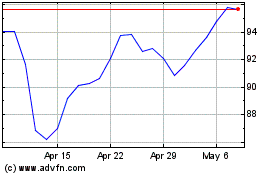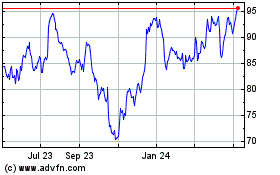Morgan Stanley tops estimates, but victory may be Pyrrhic, as
earnings fall 53%
By Justin Baer and Peter Rudegeair
Morgan Stanley became the latest big bank to beat Wall Street
analysts' expectations with its quarterly earnings results.
The victory may feel a little hollow though, and not just
because profits at the New York firm dropped 53%. Analysts'
estimates have been falling sharply since the start of the year,
lowering the bar for the banks.
J.P. Morgan Chase & Co., Citigroup Inc., Bank of America
Corp. and Wells Fargo & Co. also cleared that lower hurdle,
besting analysts' earnings forecasts in the past week. If Goldman
Sachs Group Inc. follows suit when it reports earnings Tuesday, all
six big U.S. banks will have exceeded the consensus for the first
time since 2013, according to data from Thomson Reuters.
Despite numerous problems for banks this year -- difficult
trading conditions, a pause in deals, stubbornly low interest rates
-- bank shares rallied about 7% over the past week as investors
decided things weren't as grim as analysts predicted.
Wall Street's outlook for bank earnings darkened throughout the
first quarter, and estimates continued to drop even after it
ended.
In Morgan Stanley's case, the firm reported a profit of 55 cents
a share, easily beating the estimate of 46 cents. But that figure
wouldn't have looked as good if compared with analysts'
expectations as of April 1 -- 65 cents a share or a month earlier,
when the expectation was about 80 cents a share.
The quarterly profit at Citigroup and Bank of America also would
have fallen short of the average earnings forecasts analysts had
posted at the end of March.
Of course, the idea of companies jumping over lowered
expectations isn't new in any industry. Of the companies in the
S&P 500, about 73% that have reported so far have beaten
estimates, according to Howard Silverblatt, senior index analyst at
S&P Dow Jones Indices.
"The good news is you beat," he said. "The bad news is that
you're...short of what you did last year." At the big banks, Morgan
Stanley's first-quarter profit decline of 53% followed a 27%
decline at Citigroup, a 13% drop at Bank of America and a 7%
decline at J.P. Morgan.
The first quarter was unusual for big banks in that the usually
busy trading months of January and February were actually slow,
hindered by plummeting stock prices and related volatility.
But just as executives at various banks shared updates about the
tough markets, conditions were about to improve in March. The
result was that analysts overshot and were too pessimistic when
results were announced in April.
"There are more predictable industries out there, for sure,"
said Glenn Schorr, a bank analyst with Evercore ISI. "Because the
financial industry is very influenced by rates, credit spreads, by
market-activity levels and by regulations. And those are hard to
predict."
Many bank executives are loath to give investors specific
forecasts or targets on profitability. Executives from Goldman
Sachs have sidestepped questions on what the firm's returns should
be, arguing that too many things can go wrong.
"The perils of putting out a target is you get asked about it
every time, every quarter, until you finally get there," James
Gorman, Morgan Stanley's chairman and chief executive, said during
a conference call with analysts.
In the first quarter, Morgan Stanley's revenue tumbled 21% to
$7.79 billion, slightly shy of analyst expectations. Net income
dropped to $1.13 billion from $2.39 billion a year earlier.
Mr. Gorman told analysts in January that the firm would push to
boost its return on equity, an important measure of profitability,
to 9% to 11% by the end of next year. In the most recent quarter,
return on equity fell to 6.2% from about 14% a year earlier,
highlighting that the firm has a way to go before meeting its
profitability target.
Morgan Stanley executives based their target on revenue gains of
4% a year, continuing cost cuts and regulators' blessing for the
firm's dividend and share-buyback plans.
"I'll give Morgan Stanley credit for stepping up and putting out
it out there," said Jeff Harte, an analyst with Sandler O'Neill +
Partners LP. "But they run the risk of overpromising and
underdelivering for things that are out of your control."
Morgan Stanley and other big banks are muddling through a steep
slump in their debt-trading business. The downturn prompted the
firm to cut jobs from the unit, which has weighed down Morgan
Stanley's return on equity.
Trading revenue fell 34% to $2.69 billion from $4.08 billion in
the first quarter of 2015, a sharper drop than some peers.
Revenue from trading in debt, currencies and commodities fell
56% to $873 million, while revenue from equity trading dropped 10%
to $2.06 billion.
In an interview, Morgan Stanley Chief Financial Officer Jonathan
Pruzan said January and February were turbulent months for its
trading business, but that it saw improvement in March and so far
in April. "The environment is clearly better, client activity is up
a bit...[but] we're going to see bouts of volatility."
The volatile markets also weakened investment-banking activity
in the first quarter, hurting a division that had been a bright
spot for Morgan Stanley last year.
Investment-banking revenue fell 16% to $990 million from $1.17
billion in the year-ago quarter. Fees from advising on mergers and
other deals rose 25% to $591 million, while revenue on stock and
bond underwriting slipped 43% to $399 million.
Revenue in Morgan Stanley's wealth-management arm was $3.67
billion, compared with $3.83 billion a year ago. In Morgan
Stanley's investment-management division, revenue fell 29% to $477
million due to losses on its private-equity and real-estate
funds.
Morgan Stanley's expenses fell 14% to $6.05 billion from $7.05
billion a year earlier. Costs from employee pay and benefits fell
19% to $3.68 billion, or 47% of revenue.
Write to Justin Baer at justin.baer@wsj.com and Peter Rudegeair
at Peter.Rudegeair@wsj.com
(END) Dow Jones Newswires
April 19, 2016 02:47 ET (06:47 GMT)
Copyright (c) 2016 Dow Jones & Company, Inc.
Morgan Stanley (NYSE:MS)
Historical Stock Chart
From Aug 2024 to Sep 2024

Morgan Stanley (NYSE:MS)
Historical Stock Chart
From Sep 2023 to Sep 2024
